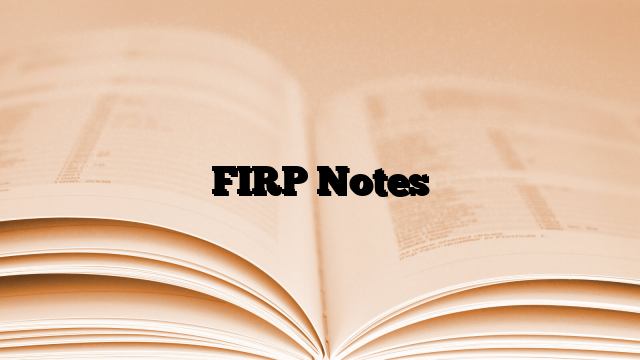In mental health care, writing clear and accurate notes is an essential part of every clinician’s job. These notes help document what happened in a session, what interventions were used, how the client responded, and what the next steps are. One of the best and most organized ways to do this is by using the FIRP format.
FIRP stands for Functioning, Intervention, Response, and Plan. It is a widely used structure for writing progress notes in mental health and behavioral health settings. The format ensures that every note meets professional, ethical, and billing standards, while also being simple and focused.
This guide will help you understand FIRP notes, how to write them effectively, and why they are so valuable for mental health professionals.
What Are FIRP Notes and Why Are They Important?
FIRP notes are progress notes that mental health professionals use to describe a client’s progress during treatment. Each letter in FIRP represents a section of the note that organizes information in a clear and consistent way.
The FIRP format helps therapists, counselors, and case managers:
- Keep accurate and organized records.
- Show that services provided are medically necessary.
- Track progress toward treatment goals.
- Communicate clearly with other team members.
- Maintain compliance with legal and insurance requirements (like Medi-Cal documentation standards).
FIRP notes are not just paperwork, they are an essential part of ethical and effective mental health care. They show the “story” of the client’s treatment, from symptoms and interventions to growth and improvement.
Breaking Down the FIRP Method
Let’s understand each part of FIRP in detail, as outlined in the Humboldt County Outpatient Documentation Manual.
1. Functioning (F)
This section describes why the service was provided and how the client is currently functioning.
It focuses on observable, factual, and relevant details such as the client’s mood, behavior, symptoms, and needs.
In this section, you should include:
- The purpose or reason for the encounter (for example, “individual therapy” or “case management”).
- The topic discussed or main issue.
- Clinical observations, what you saw, heard, or noticed.
- The current level of medical necessity, why the service is still needed.
- Any requests or concerns made by the client.
Example:
The client attended an individual therapy session to address ongoing anxiety. Appeared tense, avoided eye contact, and reported frequent panic attacks at work. The session focused on identifying triggers and discussing coping strategies.
This section connects directly to the client’s treatment plan and shows why continued services are appropriate.
2. Intervention (I)
Here, you describe what you did as the clinician or case manager during the session.
It shows how you addressed the client’s needs or goals.
Include:
- What therapeutic techniques or interventions you used (for example, CBT, mindfulness, or motivational interviewing).
- Any education, support, or resources provided.
- Progress or setbacks you observed during the session.
- Referrals or follow-ups made.
Example:
Used grounding techniques and guided deep breathing exercises to help client manage anxiety. Discussed the importance of balanced sleep and nutrition. Provided a referral for psychiatric evaluation for medication support.
3. Response (R)
This section focuses on how the client responded to your intervention.
It should describe the client’s engagement, progress, and emotional reaction in clear, behavioral terms.
Include:
- What the client said or did in response.
- How effective your intervention was.
- Any changes in symptoms, behavior, or mood.
- Homework or coping skills practiced outside the session.
Example:
Client participated actively in breathing exercises and reported feeling calmer by the end of the session. Expressed motivation to use the techniques at work. Shared that anxiety reduced from 8/10 to 5/10 during the session.
💡 Note:
If the session is case management or if the client is not present (for example, when coordinating medication or making phone calls), this section may be omitted. In that case, your note becomes a “FIP”, Functioning, Intervention, and Plan.
4. Plan (P)
The final part explains what will happen next, it outlines future actions, follow-up, and goals.
It shows continuity of care and ensures accountability.
Include:
- Next steps or follow-up plans.
- Homework or activities for the client.
- Any upcoming appointments or referrals.
- How this session contributes to the treatment goals.
Example:
Client will continue practicing relaxation exercises daily and record results in a mood log. Next session will focus on identifying cognitive distortions contributing to anxiety. Follow-up scheduled for next Tuesday.
This section should make it clear that you are guiding the client’s progress toward measurable improvement.
How to Write Effective FIRP Progress Notes
Writing FIRP notes may seem complicated at first, but once you understand the structure and purpose, it becomes a smooth and meaningful part of your clinical practice. The key is to focus on clarity, accuracy, and the logical flow between your client’s assessment, treatment plan, and progress notes. This connection is often called the “golden thread” of clinical documentation, every note should reflect how the client is progressing toward the goals written in their treatment plan.
A well-written FIRP note should show:
- Why the client needed the service (Functioning)
- What you did during the session (Intervention)
- How the client responded (Response)
- What the plan is moving forward (Plan)
By mastering a few simple habits, you can make your FIRP notes both efficient and clinically valuable.
Best Practices and Tips for Writing FIRP Notes
Be Objective and Professional
Your progress notes should always be factual, neutral, and free of personal judgment. This means describing what you observed or what the client reported, not what you assume or feel about the client.
Instead of writing:
“Client was uncooperative and lazy.”
You could write:
“Client appeared disengaged during the session and required prompting to participate.”
This language focuses on behavior and observation rather than opinion. Objectivity ensures that your notes are useful for treatment planning, legal review, and insurance audits. Remember, notes may be read by supervisors, auditors, or even clients themselves, so maintaining a respectful and professional tone is essential.
Be Concise but Complete
FIRP notes should include all necessary information without being overly detailed or repetitive. Each section (F, I, R, and P) should answer specific questions:
- Functioning: Why was the session needed? What symptoms or behaviors were observed?
- Intervention: What exactly did you do or provide?
- Response: How did the client react or benefit?
- Plan: What comes next?
Writing too much can make notes confusing and time-consuming to review. Writing too little can make them unclear or non-billable. Aim for a short paragraph (3–5 sentences per section) that clearly communicates the purpose and outcome of the session.
Example:
Client presented with low mood and fatigue. Discussed coping strategies using CBT. Client engaged actively and agreed to practice journaling before next session. Will review progress next week.
This brief note tells the full story, it’s specific, complete, and efficient.
Use Active Verbs
Strong, action-oriented verbs make your notes sound professional and focused on therapeutic work. They show that you were an active participant in the session rather than a passive observer.
Some great verbs for progress notes include:
- Therapeutic Actions: guided, modeled, explored, challenged, reflected, redirected
- Supportive Actions: encouraged, validated, empathized, assisted, comforted
- Educational Actions: taught, explained, demonstrated, clarified, provided resources
- Clinical Actions: assessed, evaluated, monitored, reviewed, interpreted
Example:
“Clinician guided client through relaxation breathing exercises to manage anxiety. Discussed triggers and validated client’s experiences.”
Using active verbs emphasizes your clinical role and highlights the interventions that support treatment goals.
Connect to the Treatment Plan
Every FIRP note should clearly tie back to the goals and objectives listed in the client’s treatment plan. This is how you demonstrate medical necessity and progress.
Ask yourself:
- Which treatment goal did this session address?
- How did my intervention move the client closer to that goal?
- What measurable progress was made?
If you introduce a new topic that wasn’t in the plan, explain why it was necessary. For example:
“Although anger management is not listed as a goal, the client’s recent conflict at work was discussed as it directly affects anxiety symptoms and job stability.”
This shows clinical reasoning and ensures your documentation remains aligned with the overall care plan.
Write Notes Promptly and Label Late Entries
According to best practices, all progress notes should be written on the same day or by the next business day after the service. Writing promptly helps you remember details accurately and keeps the client’s record up to date.
If you must write the note later, label it clearly as a “Late Entry”, including both the actual date of service and the date the note was written.
Example:
“Late Entry: This note was written on 10/22/2025 for a service provided on 10/20/2025.”
Timely documentation is not just good practice, it’s a legal and billing requirement. Auditors often look for consistency in dates and documentation time.
Protect Client Confidentiality
Progress notes should always respect the client’s privacy and dignity. Avoid including personal, non-relevant, or identifying information that is not necessary for clinical or billing purposes.
For instance, don’t record details about a client’s family conflict unless it directly relates to the presenting problem or goal. Instead of writing:
“Client argued with their brother John about family money.”
You can write:
“Client reported ongoing family conflict related to financial stressors.”
This maintains confidentiality while keeping the focus on mental health and treatment relevance. Remember, your notes could be shared in legal proceedings or released upon client request.
Ensure and Document Medical Necessity
Every progress note must justify why the service was necessary and how it benefited the client’s mental health. Medical necessity means the client continues to have a diagnosable condition that affects daily functioning and requires professional intervention.
To show medical necessity, include:
- The current symptoms or functional impairments.
- The clinical reasoning for your intervention.
- The client’s progress toward improvement.
Example:
“Client continues to experience intrusive thoughts and poor sleep affecting work performance. Provided CBT-based strategies to reduce anxiety symptoms and improve daily functioning.”
This statement connects the client’s symptoms (Functioning) to your actions (Intervention) and outcomes (Response and Plan).
Notes that fail to demonstrate medical necessity can be considered incomplete or non-billable, which can result in denied claims or audit findings.
Keep Notes Clear, Structured, and Aligned with FIRP
Use headings or clear labels for each section (F, I, R, and P) to make your note easy to read and audit.
Example:
F: Client reported low motivation and difficulty sleeping for three days. I: Provided psychoeducation on sleep hygiene and guided relaxation exercise. R: Client stated relaxation was helpful and plans to continue nightly. P: Follow up in next session to evaluate sleep progress.
This structure helps ensure that no critical element is missed and that your documentation remains consistent across sessions.
Use Concurrent Documentation When Possible
Concurrent documentation means writing your note during the session, often in collaboration with the client.
This method:
- Saves time by reducing post-session paperwork.
- Increases transparency and client engagement.
- Helps the client understand their progress and goals better.
You might say, “Let’s quickly summarize today’s progress together,” then fill in the FIRP note in real time. This keeps your notes accurate and collaborative.
Reflect the Client’s Progress and Strengths
While it’s important to document symptoms and impairments, don’t forget to record client strengths, improvements, and insights. Progress notes should show not just the problem, but also growth over time.
Example:
“Client reported using coping strategies twice this week and felt more confident managing stress. Expressed pride in staying calm during a recent family disagreement.”
This kind of documentation demonstrates progress, builds hope, and aligns with recovery-oriented practice.
Final Check Before Submitting
Before finalizing any FIRP note, review these quick questions:
- Does it show why the session was needed?
- Does it describe what I did and how it helped?
- Does it clearly show how the client responded?
- Does it explain what happens next?
- Does it connect to the treatment plan and demonstrate medical necessity?
- Is it free of bias, judgment, or unnecessary detail?
If all answers are “yes,” your note is ready to sign and submit.
FIRP notes Examples
Example 1 – FIRP Progress Note
Client Name: Sarah T.
Date of Service: October 23, 2025
Service Type: Individual Therapy
Duration: 50 minutes
Clinician: Maria Lopez, LMFT
Diagnosis: Major Depressive Disorder, Recurrent, Moderate
Goal from Treatment Plan: Reduce symptoms of depression and increase daily functioning through use of CBT and coping skills.
Functioning (Medical Necessity)
Client presented for her weekly therapy session. She appeared with flat affect and reported feeling “unmotivated” and “tired most of the time.” Client shared difficulty getting out of bed before noon and missing work twice this week due to low energy. She denied suicidal thoughts but stated she feels “disconnected” from others. Continued symptoms of low mood and poor motivation are interfering with daily functioning and job stability, indicating ongoing medical necessity for treatment.
Intervention
Clinician used Cognitive Behavioral Therapy (CBT) techniques to help client identify negative thought patterns contributing to her low motivation. Guided her through a thought record exercise focusing on the connection between thoughts, feelings, and behaviors. Discussed behavioral activation by setting one small daily task to increase sense of achievement. Provided psychoeducation on how physical activity can improve mood. Encouraged client to track activities and note emotional changes throughout the week.
Response
Client was engaged throughout the session and completed the thought record worksheet with moderate support. She was able to identify one automatic thought (“I’m too tired to do anything”) and replace it with a more balanced statement (“If I do one small thing, I might feel better”). She expressed mild optimism and agreed to try getting out of bed by 10 a.m. each morning. Reported feeling “a bit lighter” by the end of the session.
Plan
Client will practice behavioral activation by completing one daily task and journaling about her mood changes. Clinician will review progress next session and continue using CBT techniques to challenge negative thoughts. Next session scheduled for October 30, 2025.
Total Time:
Session: 50 minutes
Documentation: 10 minutes
Total Time Billed: 60 minutes
Clinician Signature:
Maria Lopez, LMFT
Example 2 – Case Management Note (FIP Format)
(Used when client is not present, so the Response section is omitted)
Client Name: Jason M.
Date of Service: October 23, 2025
Service Type: Case Management – Coordination of Care
Duration: 35 minutes
Case Manager: Amanda Reed, MSW
Diagnosis: Schizoaffective Disorder, Bipolar Type
Goal from Treatment Plan: Improve medication adherence and stability through regular coordination with psychiatrist and pharmacy.
Functioning (Medical Necessity)
Client continues to require medication support services to maintain stability and prevent relapse. He previously reported missing doses due to pharmacy delays and confusion about refills. This lack of access places the client at risk for symptom recurrence and hospitalization. Ongoing coordination is necessary to ensure continuity of care.
Intervention
Case manager contacted the client’s pharmacy to confirm refill availability for Risperidone. Verified prescription renewal with psychiatrist’s office and coordinated pickup schedule with the client’s caregiver. Provided written instructions to the caregiver regarding medication timing and refill reminders.
Plan
Follow-up call scheduled in three days to confirm medication was picked up and doses are being taken as prescribed. Next coordination check-in planned for November 1, 2025. Clinician will notify the psychiatrist if any barriers arise.
Total Time:
Service Time: 25 minutes
Documentation: 10 minutes
Total Time Billed: 35 minutes
Case Manager Signature:
Amanda Reed, MSW
Example 3 – Crisis Intervention FIRP Note
Client Name: Ashley B.
Date of Service: October 23, 2025
Service Type: Crisis Intervention (In-person)
Duration: 65 minutes
Clinician: David Kim, LCSW
Diagnosis: Generalized Anxiety Disorder
Goal from Treatment Plan: Stabilize acute anxiety symptoms and reduce panic episodes.
Functioning (Medical Necessity)
Client was referred by her workplace due to a panic attack that occurred on-site. She was visibly shaking, crying, and hyperventilating upon arrival. She reported racing thoughts, dizziness, and fear of losing control. No suicidal or homicidal ideation was reported. The client’s current functioning is significantly impaired due to acute anxiety symptoms, requiring immediate stabilization to prevent escalation.
Intervention
Clinician provided grounding and breathing exercises to reduce panic symptoms. Guided client through paced breathing (inhale 4 seconds, exhale 6 seconds) and progressive muscle relaxation. Normalized symptoms of panic and educated client about anxiety response in the body. Contacted client’s emergency contact (her sister) for transportation home and provided crisis hotline information.
Response
Client’s breathing and body tremors decreased after 15 minutes of guided exercises. She was able to speak calmly and expressed relief, stating she felt “much more in control.” Client agreed to stay with her sister for the evening and to attend her scheduled therapy session tomorrow.
Plan
Clinician will follow up within 24 hours to ensure client’s safety and stability. Will coordinate with her therapist to adjust treatment plan and consider additional coping tools for panic prevention. Client instructed to use grounding exercises daily and call the crisis line if symptoms worsen.
Total Time:
Crisis Session: 55 minutes
Documentation: 10 minutes
Total Time Billed: 65 minutes
Clinician Signature:
David Kim, LCSW
FIRP Progress Note Template
Client Information
- Client Name: __________________________________________
- Date of Service: ___________________________
- Service Type: ☐ Individual Therapy ☐ Family Therapy ☐ Group Therapy ☐ Case Management ☐ Crisis Intervention ☐ Other: ____________
- Duration of Session: ______ minutes
- Clinician/Staff Name & Title: __________________________________
- Diagnosis (DSM Code + Description): ___________________________
- Goal(s) from Treatment Plan: ___________________________________
F – Functioning (Medical Necessity)
Describe why the client needed the service and how they were functioning at the time.
- What is the reason or purpose for the encounter?
- What symptoms, behaviors, or concerns were observed or reported?
- How do these issues impact daily functioning (work, school, self-care, relationships)?
- What evidence supports continued medical necessity for services?
- Were there any client requests, needs, or risk factors (e.g., suicidal thoughts, medication issues)?
Example:
Client appeared anxious and restless, reporting difficulty sleeping and frequent worry about work deadlines. Symptoms continue to interfere with focus and job performance, indicating ongoing need for support.
Your Note:
I – Intervention
Explain what you did as the clinician or staff member to address the client’s needs.
- What techniques or interventions were used (CBT, DBT, psychoeducation, mindfulness, etc.)?
- What topics or skills were addressed?
- Did you provide any referrals, coordination, or resources?
- If applicable, describe any education, modeling, or skill-building activities.
Example:
Provided psychoeducation on anxiety triggers. Guided client through grounding exercises and reviewed coping strategies. Encouraged journaling to track emotional triggers.
Your Note:
R – Response
Document how the client responded to your intervention or service.
- How did the client engage or participate?
- Were there any improvements, insights, or resistance?
- What changes in mood, behavior, or thought patterns were observed?
- Did the client report any progress or difficulties?
Example:
Client participated actively and practiced breathing exercise in session. Reported mild decrease in tension and agreed to continue using the skill daily. Stated, “I feel more in control after breathing.”
Your Note:
(If the client was not present, you may omit this section and use FIP format.)
P – Plan
Describe what will happen next.
- What homework or follow-up actions were agreed upon?
- When is the next session or contact scheduled?
- What is the ongoing treatment focus or next step in care?
- Are any referrals, consultations, or changes planned?
Example:
Client will practice grounding techniques daily and record results in mood log. Next session scheduled for October 30, 2025. Clinician will continue CBT-based intervention to reduce anxiety and improve coping skills.
Your Note:
Time Accounting
| Activity | Minutes |
|---|---|
| Direct (face-to-face or telehealth) | _____ |
| Documentation | _____ |
| Travel (if applicable) | _____ |
| Total Time | _____ minutes |
Additional Notes (Optional)
☐ Crisis risk assessed and no immediate danger identified.
☐ Collateral contact made with: ________________________________
☐ Client declined homework/referral.
☐ Other: ___________________________________________________
Clinician Signature
Name & Credentials: ___________________________________
Date Completed: ___________________
Signature: ____________________________________________
✅ Usage Tips:
- Keep each section short but specific (2–4 sentences).
- Avoid judgmental language; use objective observations.
- Always connect interventions and responses to treatment goals.
- Label “Late Entry” clearly if writing on a different day.
Download Editable FIRP notes template here:
Some Common Challenges and Their Solutions
Writing FIRP notes can sometimes feel tricky. Here are a few frequent challenges and simple ways to solve them for smoother, more effective documentation.
- Writing too much or too little: Solution: Focus on the goal of the session and what’s relevant to the client’s treatment plan.
- Forgetting to document promptly: Solution: Use concurrent documentation, write notes with the client present or right after the session.
- Not linking interventions to goals: Solution: Always state how your action helped move the client closer to a goal.
- Confusion when the client is absent: Solution: Combine “I” and “R” (Intervention/Response) when providing services like coordination, referrals, or medication management.
- Unclear or incomplete medical necessity: Solution: Describe how the client’s condition affects daily functioning and why ongoing treatment is needed.
What Is the Meaning of FIRP Notes?
The meaning of FIRP notes goes beyond just being a format. It represents a logical and ethical way to document the “golden thread”, the connection between assessment, treatment plan, and progress notes.
By following FIRP, clinicians can clearly show that their services are:
- Medically necessary
- Client-centered
- Goal-oriented
- Compliant with regulations
Simply put, FIRP notes tell the full story of the client’s care, what’s happening, what you’re doing to help, how the client is responding, and what’s next.
How Long or Short Should FIRP Notes Be?
There is no strict word count for FIRP notes, but the general rule is short enough to be clear, long enough to be complete.
Each section can be written in 2–4 sentences, depending on the complexity of the session.
For example:
- Brief case management note: around 5–7 sentences total.
- Detailed therapy session: one short paragraph per section (F, I, R, P).
Always make sure the note includes the required information:
- Duration of session
- Intervention used
- Response observed
- Next steps
When Should You Use the FIRP Format?
The FIRP format should be used for all mental health progress notes, especially when documenting:
- Individual therapy sessions
- Family or group sessions
- Case management or coordination
- Crisis interventions
- Collateral contacts (with family, schools, or agencies)
If the client is not present (for example, when coordinating care), you can skip the Response section or combine it with Intervention.
The Bottom Line
FIRP notes are more than just documentation, they’re a professional tool that ensures every session you provide is recorded with purpose, clarity, and care. By following the Functioning, Intervention, Response, and Plan structure, you can create progress notes that are accurate, compliant, and helpful for both you and your clients. Remember: good documentation is good clinical practice. The more clear, objective, and consistent your FIRP notes are, the stronger your client care will be.






